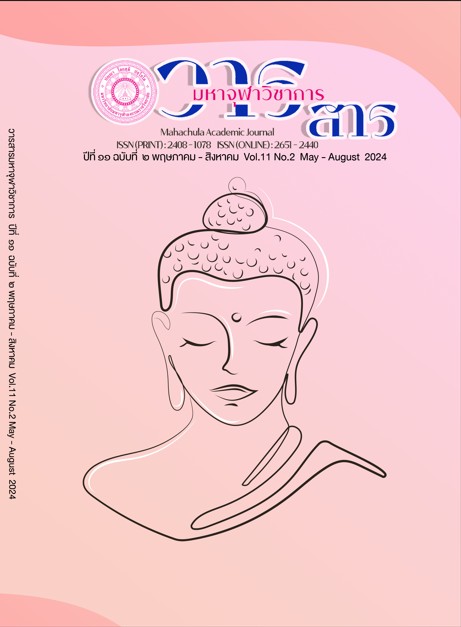การศึกษาสภาพที่พึงประสงค์ของแหล่งเรียนรู้ในโรงเรียนอนุบาลตามแนวคิดพื้นที่นักประดิษฐ์
Main Article Content
บทคัดย่อ
บทความวิจัยนี้มีวัตถุประสงค์เพื่อศึกษาสภาพที่พึงประสงค์ของแหล่งเรียนรู้ในโรงเรียนอนุบาลตามแนวคิดพื้นที่นักประดิษฐ์ เป็นการวิจัยเชิงคุณภาพ เก็บข้อมูลจากการสัมภาษณ์ทรงคุณวุฒิ จำนวน ๑๐ คน โดยการเลือกแบบเจาะจง เครื่องมือที่ใช้ในการวิจัย คือ แบบสัมภาษณ์กึ่งโครงสร้าง วิเคราะห์ข้อมูลโดยการวิเคราะห์เนื้อหา ผลการวิจัย พบว่า สภาพที่พึงประสงค์ของแหล่งเรียนรู้ในโรงเรียนอนุบาลตามแนวคิดพื้นที่นักประดิษฐ์ที่ส่งผลต่อผลลัพธ์การเรียนรู้ ๓ ด้าน ได้แก่ ผู้เรียนรู้ ผู้ร่วมสร้างสรรค์นวัตกรรมและพลเมืองที่เข้มแข็ง ประกอบด้วย (๑) พื้นที่ มีลักษณะที่ส่งเสริมพัฒนาการครบทั้งสี่ด้าน ได้แก่ สติปัญญา ร่างกาย อารมณ์และสังคม เปิดโอกาสให้เด็กได้แสดงออกตามจินตนาการด้วยการลงมือปฏิบัติอย่างอิสระเสรี รู้จักการแบ่งปัน ช่วยเหลือเอื้อเฟื้อเผื่อแผ่ ปฏิบัติตามกฎกติกาและข้อตกลงที่วางไว้ สามารถรับผิดชอบต่อบทบาทหน้าที่ที่ได้รับ จนบรรลุเป้าหมายได้สำเร็จ (๒) เครื่องมือ เป็นเครื่องมือพื้นฐานที่ปลอดภัยสำหรับเด็ก มีความหลากหลายและมีจำนวนที่เพียงพอ จัดแบ่งตามหมวดหมู่ ให้ใช้ตามวัตถุประสงค์ และ (๓) วัสดุ เป็นวัสดุที่มีความปลอดภัยปลอดสารพิษสำหรับเด็ก หาได้ง่ายรอบตัวตามธรรมชาติหรือเป็นวัสดุเหลือใช้ มีความหลากหลายในด้านรูปทรง รูปร่าง ผิวสัมผัสและสีสัน
Article Details

อนุญาตภายใต้เงื่อนไข Creative Commons Attribution-NonCommercial-NoDerivatives 4.0 International License.
เอกสารอ้างอิง
กระทรวงสาธารณสุข, คู่มือเฝ้าระวังและส่งเสริมพัฒนาการเด็กปฐมวัย, (นนทบุรี: สำนักงานกิจการโรงพิมพ์องค์การสงเคราะห์ทหารผ่านศึก, ๒๕๖๒), หน้า ๔-๘.
กระทรวงสาธารณสุข, คู่มือการใช้อุปกรณ์ส่งเสริมพัฒนาการเด็กวัยแรกเกิด–๕ ปี, (กรุงเทพฯ: สถาบันราชานุกูล, ๒๕๕๕), หน้า ๗-๘.
ชนิพรรณ จาติเสถียร, กันตวรรณ มีสมสาร และ อภิรดี ไชยกาล, การพัฒนาเด็กปฐมวัยอย่างเป็นองค์รวม, (กรุงเทพฯ: สมาคมอนุบาลศึกษาแห่งประเทศไทยในพระราชูปถัมภ์สมเด็จพระเทพราชสุดาฯ สยามบรมราชกุมารี, ๒๕๖๐) หน้า ๑๓.
แผนพัฒนาเศรษฐกิจและสังคมแห่งชาติ ฉบับที่ ๑๓ (พ.ศ.๒๕๖๖-๒๕๗๐), (๒๕๖๕, ๑ พฤศจิกายน), ราชกิจจานุเบกษา, เล่ม ๑๓๙ ตอนพิเศษที่ ๒๕๘, หน้า ๑๒๑-๑๒๒.
พระราชบัญญัติพื้นที่นวัตกรรมการศึกษา พ.ศ.๒๕๖๒, (๒๕๖๒, ๓๐ เมษายน), ราชกิจจานุเบกษา, เล่ม ๑๓๖ ตอนที่ ๕๖, หน้า ๑๐๓-๑๐๔.
พระราชบัญญัติการพัฒนาการศึกษาปฐมวัย พ.ศ.๒๕๖๒, (๒๕๖๒, ๓๐ เมษายน), ราชกิจจานุเบกษา, เล่ม ๑๓๖ ตอนที่ ๕๖, หน้า ๙-๑๐.
พรทิพย์ ประยุทธเต, “การศึกษาและออกแบบของเล่นสำหรับเด็กปฐมวัยเพื่อส่งเสริมพัฒนาการเรียนรู้ด้านการคิดอย่างเป็นระบบ”, วิทยานิพนธ์ครุศาสตร์มหาบัณฑิต, (เทคโนโลยีการออกแบบผลิตภัณฑ์อุตสาหกรรม: สถาบันเทคโนโลยีพระจอมเกล้าเจ้าคุณทหารลาดกระบัง, ๒๕๕๗).
พฤทธิ์ ศิริบรรณพิทักษ์, งานปาฐกถาศาสตราจารย์ ดร.วิจิตร ศรีสะอ้าน ครั้งที่ ๑๑ ประจำพุทธศักราช ๒๕๖๓: เรื่อง การพลิกโฉมระบบการศึกษาเพื่อตอบโจทย์การพัฒนาประเทศ. จุฬาลงกรณ์มหาวิทยาลัย (๒๕๖๓, ๑๘ มกราคม).
สำนักวิชาการและมาตรฐานการศึกษา กระทรวงศึกษาธิการ, คู่มือหลักสูตรการศึกษาปฐมวัย พุทธศักราช ๒๕๖๐ สำหรับเด็กอายุ ๓ - ๖ ปี, (กรุงเทพฯ: โรงพิมพ์ชุมนุมสหกรณ์การเกษตรแห่งประเทศไทย จำกัด, ๒๕๕๑) หน้า ๘.
นรรธพร จันทร์เฉลี่ย เสริบุตร, กระบวนการเรียนรู้พัฒนาทักษะศตวรรษที่ ๒๑, (เชียงใหม่ : มูลนิธิโรงเรียนสตาร์ฟิชคันทรีโฮม, ๒๕๖๓), หน้า ๖.
Fleming, L. World of making, (U.S.A.: Corwin, 2515), 16-22.
Organization for Economic Co-operation and Development, PISA 2018 Insight and interpretations, (Cyprus: OECD, 2019), 41.


